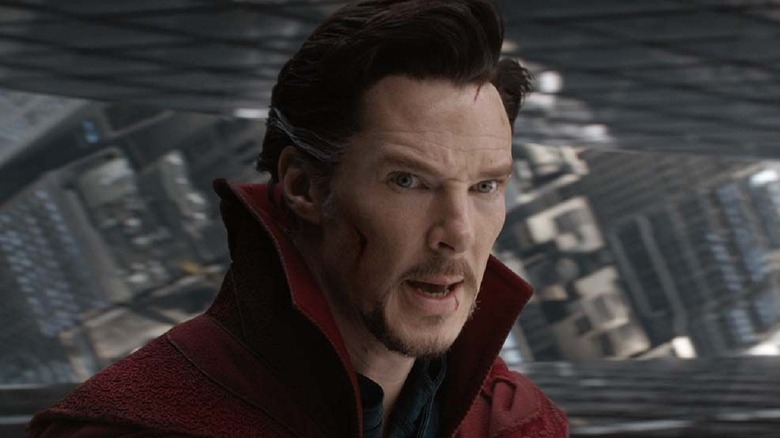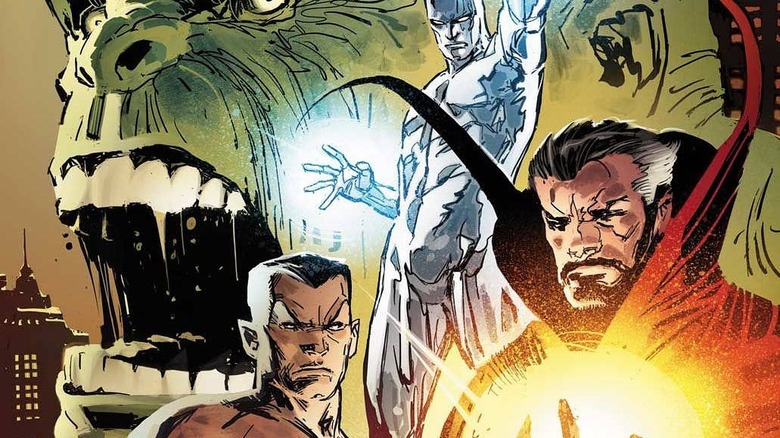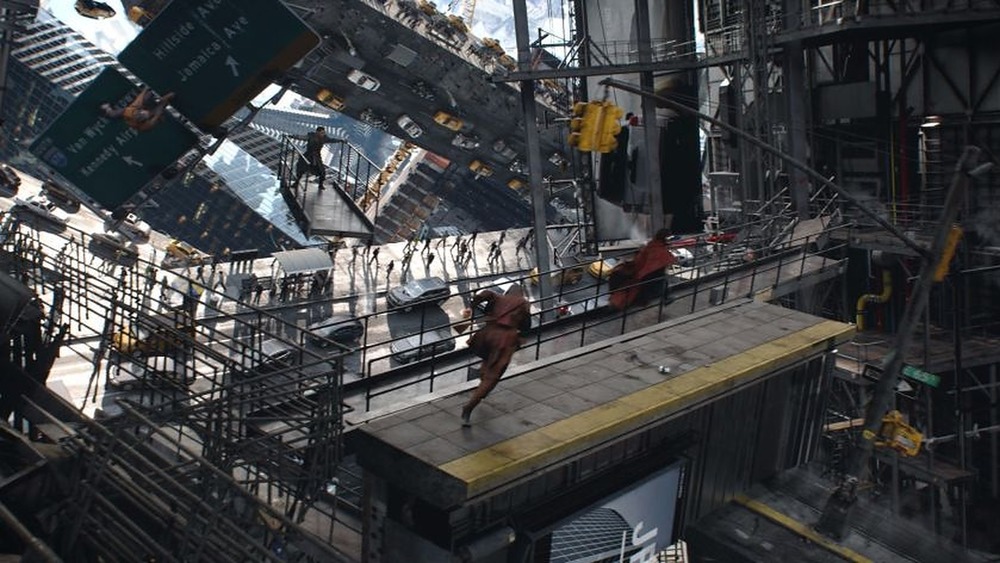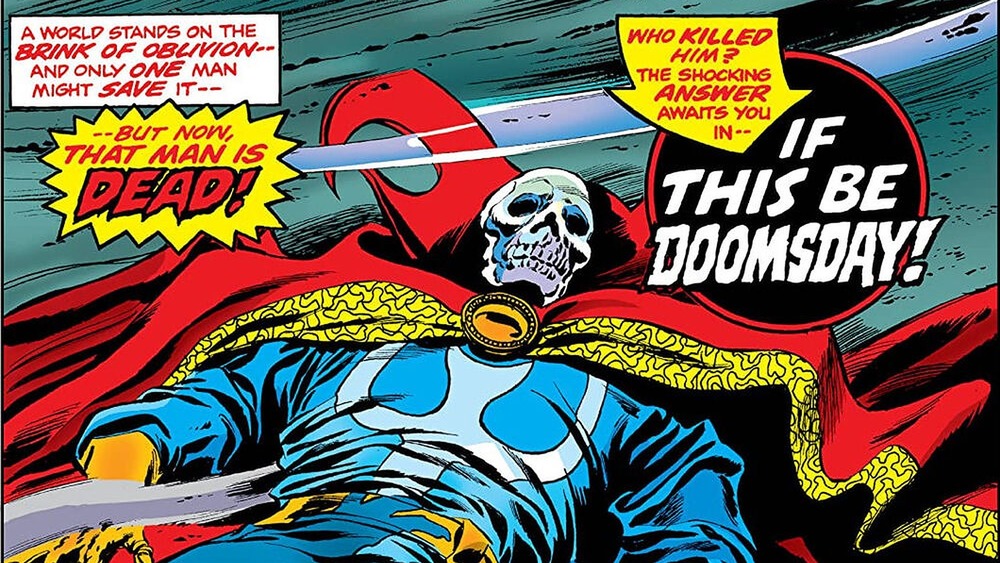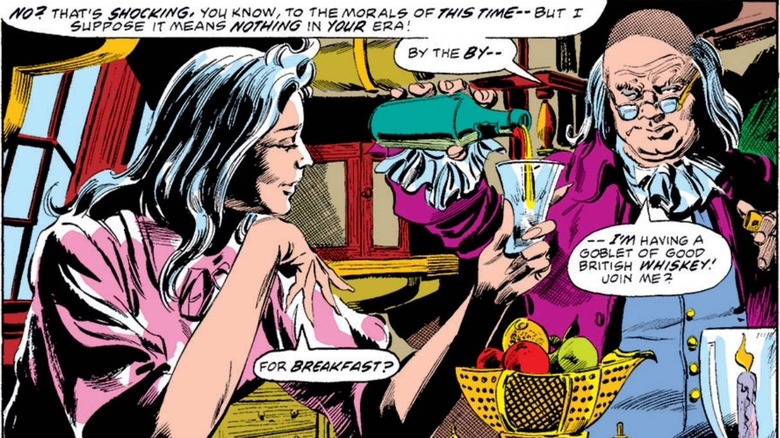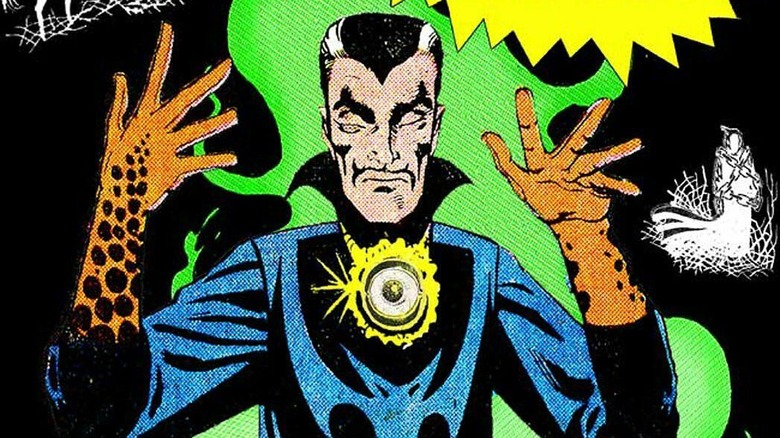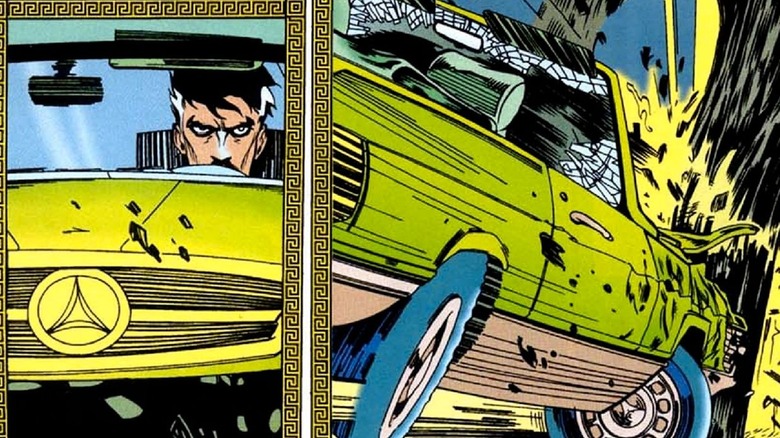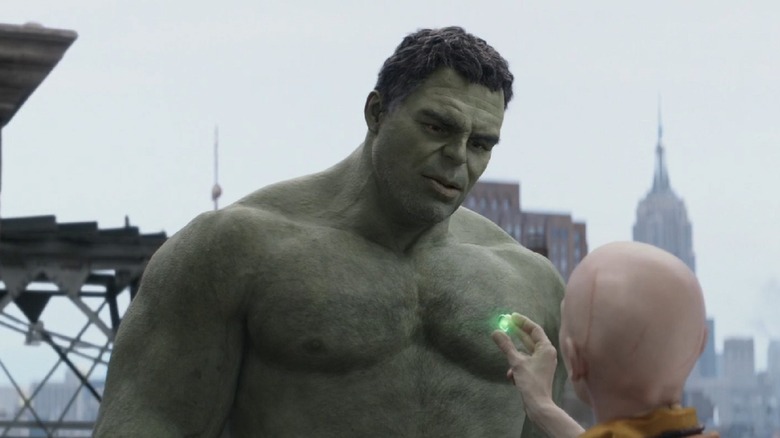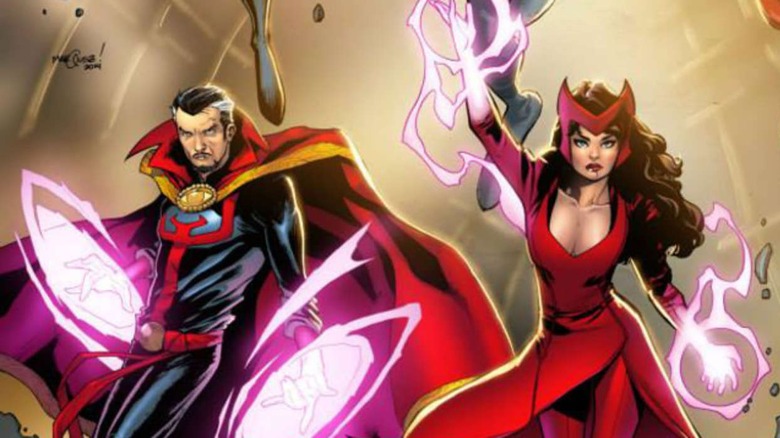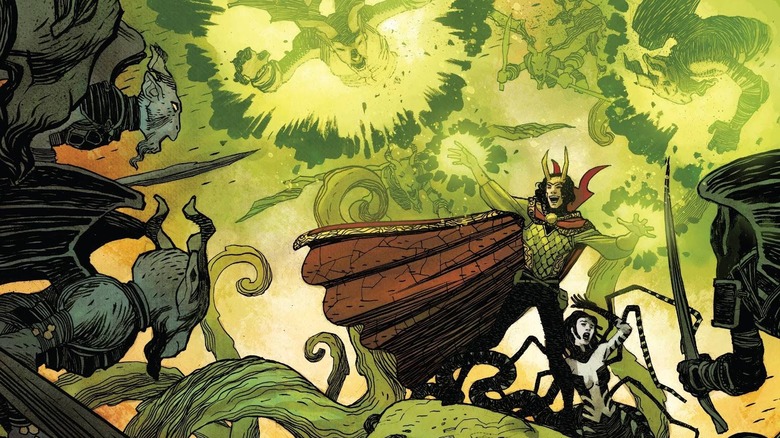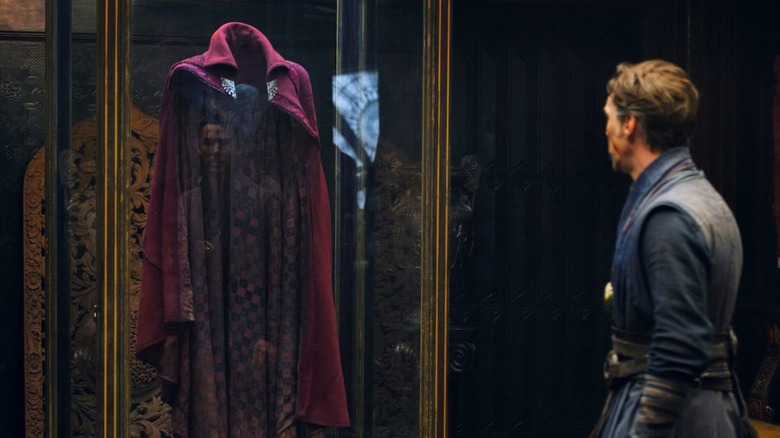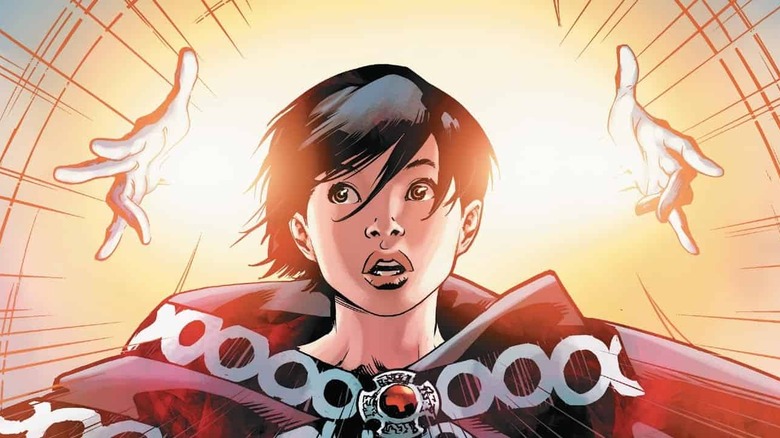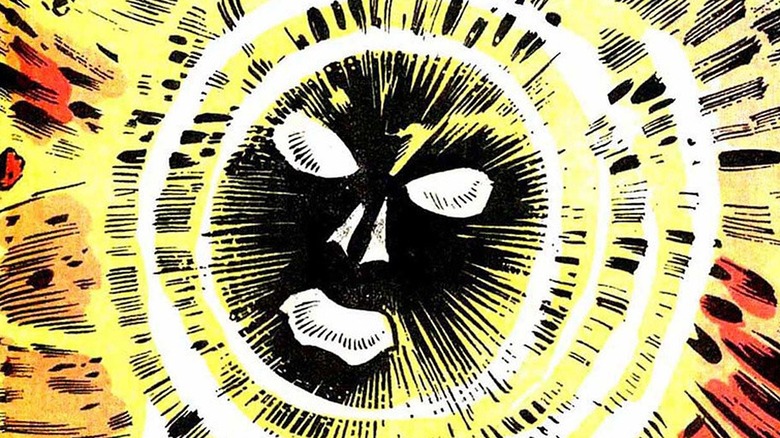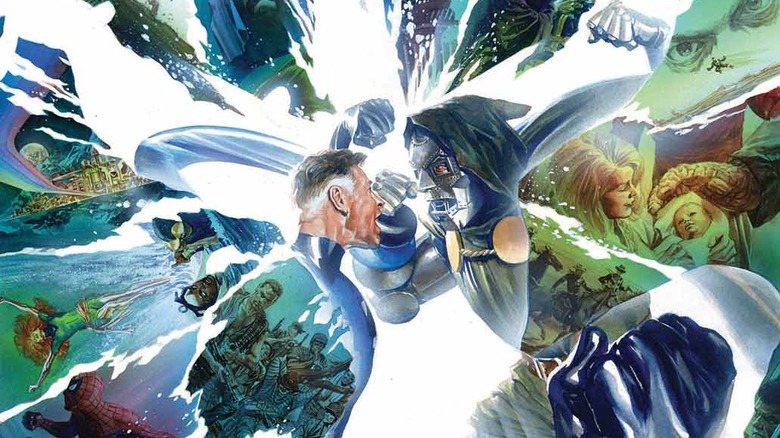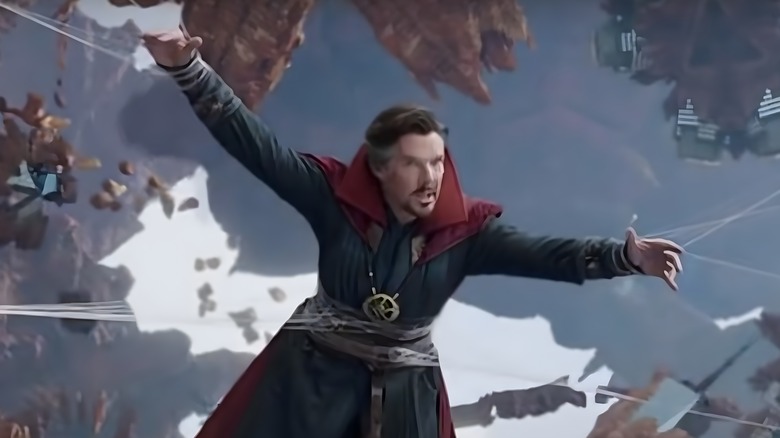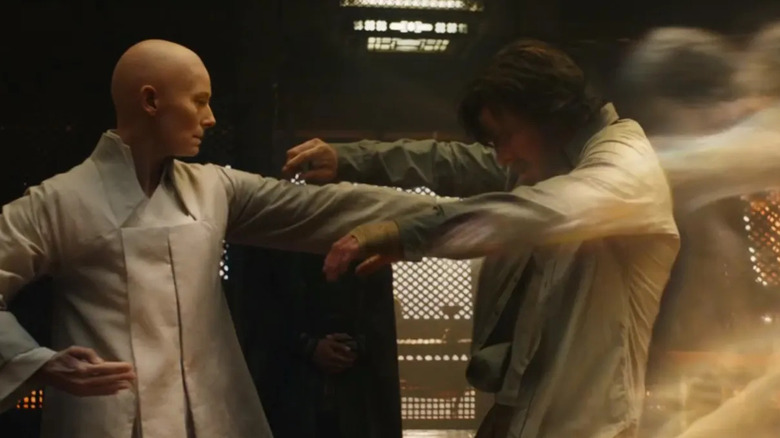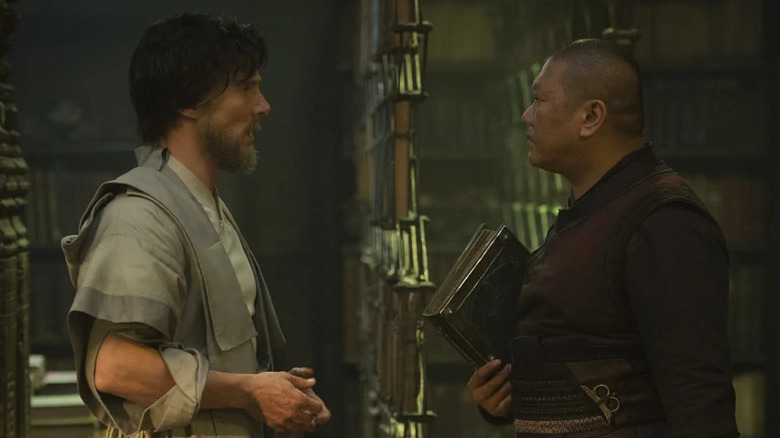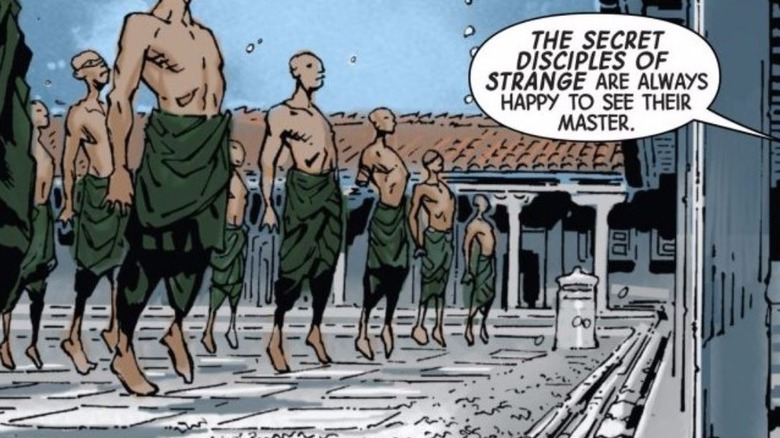Marvel Lied To You About Doctor Strange
Something strange is going on, and everything is not what it seems. The story of Marvel's Sorcerer Supreme lends itself naturally to some misdirection. We're dealing with magic and multiverses, after all. But as Doctor Stephen Strange's story has evolved over the decades at the hands of different creatives from the comic book panel to the big screen, there are some points at which it definitely feels like we're being misled, even lied to, by the folks over at Marvel.
Doctor Strange is an unconventional hero, to say the least. Rather than relying on brains, bank, or brawn like other, more familiar superheroes from both the DC and Marvel universes, Strange uses magic to protect the mortal realm from evil. The art and stories tend more toward the psychedelic and philosophical than most audiences are familiar with, and we can thank Marvel for that. But what else do the art and stories do? Through continuity rewrites, trailer clips, and cover designs, Marvel shrouds Doctor Strange in a cloak of lies more nebulous than the Cloak of Levitation.
Reunited and it feels so confusing
While he's mainly shown up to assist the Avengers in the Marvel Cinematic Universe, the original Doctor Strange from the comics established another superhero team, the Defenders, which originally included Strange, the Hulk, Namor, and the Silver Surfer. But due to the individualistic natures of the members, the group also featured a rotating cast of heroes like Nighthawk, Gargoyle, and Valkyrie.
Would Marvel really have us believe that Doctor Strange's Defenders can't ever reunite again? Marvel itself describes the Defenders as a "non-team" that was never all that united in the first place, but this independence is what gave them their power when they came together. Yet in "The Defenders" #124, before it was retitled to "The New Defenders" in the 125th issue, we learn of a prophecy stating that if the original four Defenders ever came together again, the whole world would be destroyed.
This proclamation from the all-seeing Tribunals really impeded any future writers from using the original and well-known characters, so eventually, we got a retcon in "Incredible Hulk" #370 where Strange reveals that he's learned the truth about the Tribunals' warnings. They were nothing but a cosmic hoax the whole time, a lie that fooled the Defenders as much as it fooled the readers.
Doctor Strange's trail(er) of destruction
The trailer for the 2016 "Doctor Strange" film starring Benedict Cumberbatch showed scenes of cities collapsing in on themselves in the famous style of Christopher Nolan's "Inception" from 2010, as well as characters delivering spacetime-bending blows to the sides of buildings. This trailer, as well as the existing canon of Marvel showdown scenes, led us to believe that we were in for the usual amount of carnage perpetrated for the ultimate survival of the planet.
After all, this level of city-levelling violence is typically seen as an end that justifies the means. An entire city destroyed rather than an entire planet is the usual trade. In fact, there's controversy in superhero films themselves from both of the major cinematic universes over the fact that heroes seem to show so little regard for saving people on their quests to, well, save people. The Marvel Cinematic Universe is generally regarded as handling this slightly better than DC, though its films certainly still engage in their share of gratuitous destruction.
In the case of Doctor Strange, though, the destruction happens before Strange even arrives. In what's often considered the most subversive MCU climax yet, Strange's strategy in his fight is to manipulate time rather than to use physical force. In fact, his big "move" is literally to die over and over at the hands of his enemy inside a time loop of his own creation. This bizarre and almost anti-climactic tactic allows him not only to win but undo the destruction, instead of the opposite.
Doctor Strange's cover story
The cover of "Doctor Strange" Vol. 2 #12 gives us every indication that the shocking demise of Doctor Strange awaits us within its pages. "Who killed him?" it asks dramatically. Another blurb on the same cover is ostensibly even less ambiguous. "A world stands on the brink of oblivion — and only one man might save it — but now, that man is dead!" Next to a flesh-stripped skeleton wearing Doctor Strange's costume, the suggestion is pretty strong that in this issue, the sorcerer will meet his end.
Of course, the cover doesn't use any proper nouns to confirm who's died, just a lot of heavy visual implication. The plot of the issue is as trippy as ever and as bewildering as the cover warrants. After Strange battles and defeats the Masked Master of the Mystic Arts, he unmasks him, only to reveal his own face. Oh, but then he unmasks him again to reveal the face of Death itself, whose face then finally changes into that of Baron Mordo. So while the ingredients suggested on the cover — Doctor Strange, death, and defeat — are present in the actual story, it's not in the way we're led to believe.
Bewitched and re-witched
One of the most hated retcons in Doctor Strange's multi-history was the seduction of his disciple and lover, Clea, by Benjamin Franklin. The dalliance happened over the course of a story arc in which Strange and Clea traveled back through time to learn the history of the occult in America. Strange had always wanted to meet Ben Franklin, only to have him turn into a sexual rival in "Doctor Strange" #18. This was the last Doctor Strange story arc for writer Steve Englehart, and it was retconned quickly in the very next issue.
The encounter was explained away as an illusion by Marv Wolfman, the editor who took over as writer for the series. Strange uncovered a dastardly illusion by which the sorcerer Stygyro was masquerading as Benjamin Franklin, who couldn't possibly have been with Clea because he was at that moment attending the Second Continental Congress.
This retcon, though, was itself altered once again in "Deadpool" Volume 3. Here, we learn that Strange holds a grudge against Ben Franklin's ghost for sleeping with Clea, which means that Stygyro's artifice was an illusion itself. So in a way, we were lied to twice.
Start at the beginning
Find it odd that the origin story of the deified doctor didn't come up until issue numbers that were well into the 100s? Well, Marvel misled you about the chronology of Strange's beginnings. Doctor Strange doesn't have as many issues as you think he does, and there basically isn't an Issue #1 for the original volume of "Doctor Strange."
This lie mostly owes itself to the stage of Marvel's evolution when Doctor Strange was introduced in the early 1960s. The Marvel brand was relatively new, having developed first from Timely Comics to Atlas Magazines until the Marvel era began in 1961, partly in response to the commercial success of superhero titles reintroduced by rival DC Comics in the late 1950s.
Doctor Strange first appeared in "Strange Tales" #110 and ended up being a popular character, enough so that Marvel saw fit to give him his own comic. They preserved the continuity of the audience's investment in the narrative by keeping the numbering of "Doctor Strange" Vol. 1 the same as "Strange Tales." So what would really be issue #1 of "Doctor Strange" is numbered #169.
The retcon that crashed and burned
The car crash that ruined the hands of Stephen Strange was the most pivotal moment of his life, the impetus for a twofold journey of heroism and humility. This origin story served, essentially, as a surgical extraction of the greatest source of his pride — his status as a renowned surgeon. The crash itself was partly a result of his hubris, which makes its role in his transformation that much more poignant.
But in "Doctor Strange, Sorcerer Supreme" Vol. 1 #85, writer J.M. DeMatteis adds a crucial detail that changes everything. Apparently, the Ancient One knew of a prophecy that Strange would one day become his successor. Baron Mordo was none too happy to find out about this, and he vindictively made it his mission to torture Strange psychologically all throughout his childhood. The torture was so unbearable that Strange crashed his car into a tree "with a surgeon's precision," hoping for a swift end to a lifetime of torment. But don't let this story addition fool you. It was dropped by later writers because it didn't make much sense at all in the context of Strange's origin and arc.
Marvel plays fast and loose with the definition of 'death'
The Ancient One told us in 2016's "Doctor Strange" that you can't see into the future beyond your own death. But for our purposes, this was a lie, or at the very least, an ambiguous and misleading statement. You can see beyond certain kinds of death because, apparently, some kinds don't "count" in the same way.
Remember the moment in "Infinity War," when Strange saw over 14 million different futures and only found one in which the Avengers triumphed over Thanos? This was a dramatic and pivotal reveal, but according to everything we know about seeing into the future, it shouldn't have been possible. Strange was one of the victims of Thanos' "snap," which occurs prior to the final confrontation with the Mad Titan. So he shouldn't have been able to see any of these futures because they would all occur after his demise.
A deleted scene from "Avengers: Endgame" released exclusively on Disney+, though, features an alternate conversation between the Ancient One and the Hulk where she tells us that "willing something out of existence" isn't the same thing as killing someone. And since Thanos willed Strange into dust instead of murdering him in a more traditional way, that's the workaround. The scene itself has other continuity problems and was altered for the final film, but because Strange seeing beyond his own "death" was a canonically critical part of the film, it had to be a lie that Thanos' snap counted as a death the way we thought it did.
A chaotic revelation
It seems that Doctor Strange has an odd habit of spouting off secret, surprising knowledge that, through his mystical powers, he alone has the power to discover and impart. However, there is one issue with this. Because of the deus ex machina-style of these revelations, we just have to take Strange's word for it that he acquired the information. He doesn't really have to back up his claims, which means that they don't always fit logistically into canon — even his own!
One of the least well-thought-out assertions Strange makes is that there's no such thing as chaos magic at the end of "Avengers Disassembled." Strange insists that Scarlet Witch's powers exist because she's a mutant, rather than as a manifestation of chaos magic. This doesn't make any sense, since Strange uses chaos magic himself! We later learn explicitly that he was lying to prevent mortals from knowing too much about chaos magic. After all, it would be easier to convince them if no one believed it was real in the first place. A lie is really the only way this bizarre statement makes any sense.
Doctor Strange and the loser illusion
Marvel fans all thought Strange lost his mantle as Sorcerer Supreme in a sorcerer's tournament in which Loki bested him. Apparently, every few decades, the Vishanti host a tournament of the world's greatest sorcerers, and Loki just proved himself to be better, or so we're told in "Doctor Strange" #383.
But that's not the whole story. We learned shortly thereafter that Strange actually won, but the Vishanti decided they didn't want a mortal to have the title and just gave it to Loki anyway, who apparently wasn't even competing. Even still, that's not the biggest reveal. We finally learn that the entire tournament itself was an illusion, and honestly, we all should've expected a lie like that from the trickster god of Asgard.
The whole tournament being a trick to get Strange to give up his job makes a lot more sense to the many fans questioning why in the world Strange surrendered his title to Loki of all people. Confusing specifics aside, writer Donny Cates, who spawned this story, told CBR that this tale was in many ways a reimagining of Strange's beginnings — a freak incident causing him to lose the job he's held for so long, forcing him to "chart a new path back to what he lost."
Doctor Strange's artifacts were just saved for later
Strange allegedly destroyed all of his magical items at the conclusion of the second volume of the "Doctor Strange" comics in an attempt to prevent an adversary from using them against him. For practical purposes, though, this act was retconned. After all, later writers might want to have these relics handy! The Sorcerer Supreme's magical artifacts are an essential part of the character and add a lot to the power he's worked so hard to wield.
In fact, one of the most recognizable artifacts is so integral that it basically serves as its own character in the film — the Cloak of Levitation. The vivacious vestment is just one magical item among many that are essential not only to how Strange uses magic to defeat his enemies but to the process of acquiring magic that's made him who he is. The Book of Cagliostro from the library of the Ancient One, a tome full of age-old spells, is another critical example.
Because of how important these objects are, Roy Thomas decided to bring them back when he started his time on "Doctor Strange, Sorcerer Supreme." The workaround included a reveal that they weren't actually destroyed. Instead, they were teleported away and saved by the magical, omnipotent Agamotto, who eventually returned them to Strange — and to canon.
Forget me not
Did you think Strange didn't care about his assistant, Casey Kinmont, whose soul he promised to reunite with her body again? It certainly appeared that way. At the end of Mark Waid's 2009 miniseries, "Strange," Casey's soul was separated from her body, and Strange promised that he would rectify the situation. But the multiple writers who followed Waid didn't remember this promise in any of their stories, meaning Strange appeared to forget, as well.
In an uncommon turn of events, though, Waid was able to retcon one of his own stories when he returned to work on "Doctor Strange." He didn't change the fact that Strange forgot his promise over all that intervening time, but he did tell us why. Apparently, the thought of Casey's fate had been distracting Strange in battle, so an ally did the sorcerer a solid and wiped her from his mind. So he did technically forget, but it was forcibly rather than out of negligence. Her perceived abandonment even serves as a plot point in Waid's new run.
Letters from the sky
We were led to believe that the sorcerer Sise-Neg, whose inspiration many felt was supposed to be God himself, was actually well-received by the religious community. This lie not only took advantage of the audience but of Stan Lee himself!
When the comic titan read "Marvel Premiere" #14, he was stunned and concerned about basing a character upon God and the potential controversy it could draw from the religious community. His concern was not without merit. The name Sise-Neg is Genesis backwards, and Sise-Neg is assumed to be God because he's gathered the power to create reality in his image after traveling back to the beginning of time. And if that wasn't too on the nose, he also destroyed Sodom and Gomorrah (an act biblically attributed to God).
Stan Lee thought there should be a retraction stating that Sise-Neg was meant to be a god but not the God. That is, until a letter came from a priest saying he loved the story! Marvel printed that letter in a subsequent issue. But according to CBR, it turns out it was a fake written by Steve Englehart and Frank Brunner, the artists of the comic itself!
Doctor Strange's time of death
Think Doctor Strange is still alive? He's not, as Marvel pulled off one of the greatest lies ever in plain sight. Sure, they're releasing comics about him, but the original Marvel Universe Doctor Strange was killed in the Secret Wars crossover event in 2015. Earth was remade after everything was destroyed, but that's the key — remade, not resurrected.
The efforts of Molecule Man and company were enough to rebuild Earth-616, the primary location of events in the Marvel Universe, after the "Secret Wars" events on Battleworld. This world, however, is essentially a copy of Earth-616 with a few notable differences that would make it not technically the "same," as fans have pointed out. Though functionally it is equivalent, as of "Secret Wars" #9, the new designation of Earth-616 is "Earth Prime/Prime Earth" to reflect this innocuous but still technical difference.
And Doctor Strange was killed on the old Earth-616, so when the new one was remade, he wasn't a part of the company that rebuilt it. Rather, he was rebuilt himself. So, he's a carbon copy of Doctor Strange but a relative stranger in a strange land, nonetheless.
Doctor Strange: Master of What, Exactly?
In both the comics and the MCU, Doctor Strange goes by the title of "Master of the Mystic Arts," and though the two canons treat the title very differently, both versions of Strange fall short of the title's grandeur.
In the comics, the title was self-applied by Strange, and for the most part, unique to him. As there is no academy at Kamar-Taj to bestow official titles -– merely a one-on-one tutelage with the Ancient One -– Strange began using the title to signify his abilities before officially ascending to Sorcerer Supreme. While a self-coined rank isn't necessarily false, it certainly can't be accepted as automatically true. So says we, the Poet-Emperors of the Listicle.
In the MCU, Strange is granted the title in a semi-official manner after studying at the academy, but only out of emergency protocol. Strange only spent a fraction of the time studying that his peers did, and learned much of his magic in ways that broke regulations and safety protocols, such as stealing forbidden books and playing around with an Infinity Stone. He only "graduates" to "master" when Kaecilius attacks the order and Strange is conscripted to combat him.
Strange was meant to be the best of us
We previously mentioned the exchange between the Ancient One and the Hulk in "Avengers: Endgame," a dialogue that played fast and loose with the franchise's established rules of time, space, and death. But the scene also brings up another major bit of continuity confusion, this time in the form of the Ancient One's feelings and opinions. When Hulk informs the Ancient One that Strange gave the Time Stone to Thanos, the old sorceress is stunned. She stammers out "Strange is meant to be the best of us" and accepts that he must have acted for a reason, then hands Hulk her Stone.
The problem with that interaction is that it takes place around five years before the events of "Doctor Strange," and when that film begins, the Ancient One thinks Strange is an arrogant, selfish, reckless snob with too small a mind and too big an ego. She tells him upon first meeting him that his view of the universe is myopic and that he is untouchable. Even further, after she kicks him out, she confides in Mordo her worry that Strange's impudence and hubris might make him the next Kaecilius. In short: when the Ancient One meets Strange, her opinion of him is low. So how, then, does she also feel that he is meant to be the best of us?
Wong is Strange's friend
In the MCU, Strange and Wong are more than fellow sorcerers, they're roommates and close friends. They joke with each other, tease each other, and even trade the title of Sorcerer Supreme without (almost) any hard feelings. Even their differences –- like Strange's brashness and Wong's temperance –- complement the other and create a whole better than its parts. They are, in every major way, true equals. Alas, that mutual respect and love is, for the most part, an invention of the MCU.
For the vast majority of Wong's existence in Marvel comics -– dating back to 1963's "Strange Tales" #110 –- the character has been described as an "assistant," servant," or "manservant." His entry in the Marvel Database even begins with a quote expressing his bitter frustration at the demeaning position: "When I dedicated my life in service to you as Sorcerer Supreme ... I remember I closed my eyes and prayed that one day I would grow up to be a second-rate Jarvis." Though Wong's status in the comics has generally improved over the years, from blatant stereotype to respected member of Strange's circle, he's never achieved even half the respect, admiration, and success that his MCU counterpart has.
Magic is free
In "Doctor Strange," the film in which the MCU first introduced magic (as it purposefully left the Scarlet Witch's powers unexplained in "Age of Ultron"), the characters are as clear as they can be about the way in which magic works. The Ancient One gives Strange multiple lessons on the existence, inner workings, and usage of magic, at one even explicitly stating where magic comes from: "We harness energy, drawn from other dimensions of the multiverse, to cast spells." Throughout the movies thus far, she seems to be correct -– Strange and company channel energy that seems to come from nowhere and cost nothing. But Strange's comic book counterpart has learned the hard way, multiple times, that all magic has a cost.
As writer Jason Aaron told CBR, "Everything that Strange does has to have a cost ... Whether it's somewhere else in the world that pays that effect, some other dimension, or Strange pays it personally, it's still got to get paid." In order to pay sorcery's steep asking prices, Strange has resorted to taking loans from unusual places –- the most egregious of which is the Secret Disciples of Strange. This collection of monks is kept hidden at Kamar-Taj by Strange and Wong, and they exist for the sole purpose of settling Strange's magical tabs for him –- whenever Strange a spell, one or more of the monks is wracked with pain, sometimes even suffering permanent injury. Hopefully, when the MCU's Strange learns the high cost of magic, he won't resort to the same unconscionable measures.
